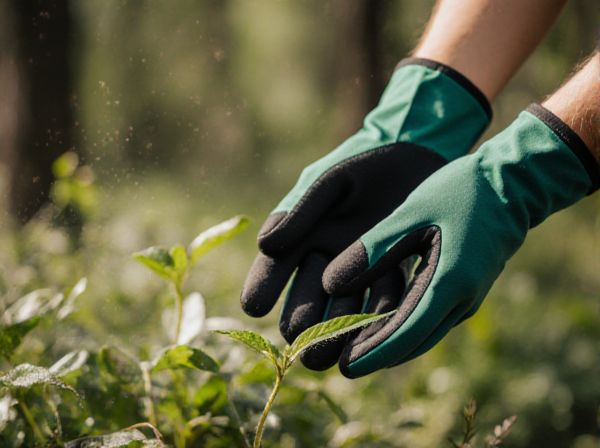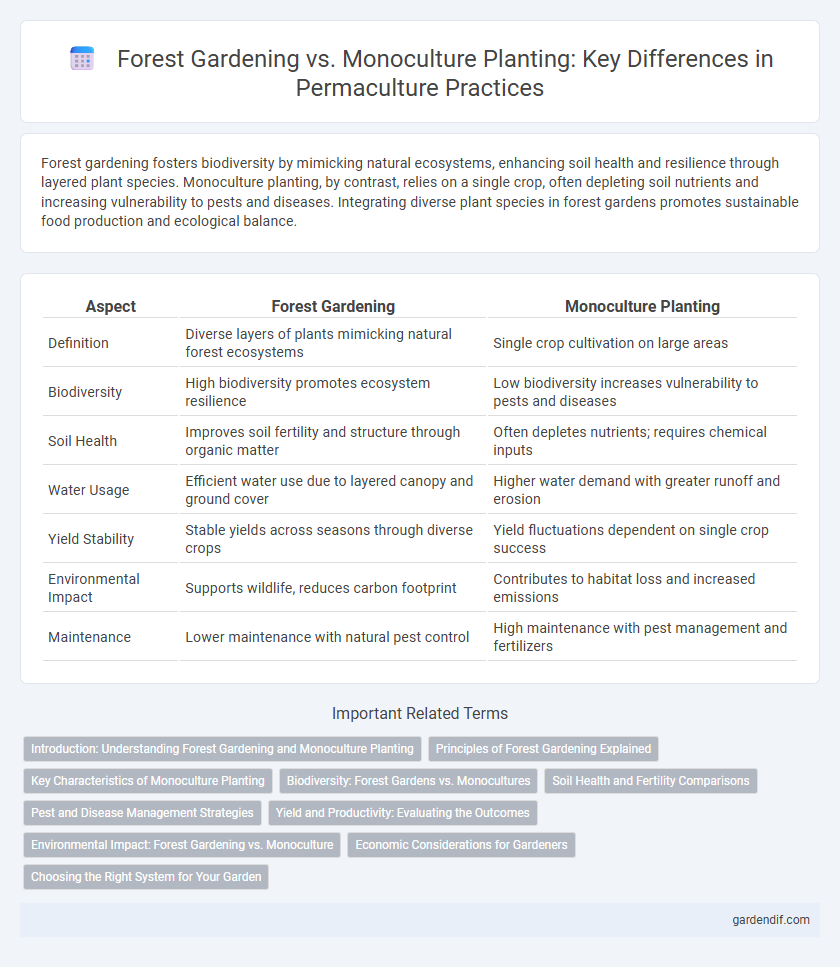
Forest gardening vs Monoculture planting Illustration
Forest gardening fosters biodiversity by mimicking natural ecosystems, enhancing soil health and resilience through layered plant species. Monoculture planting, by contrast, relies on a single crop, often depleting soil nutrients and increasing vulnerability to pests and diseases. Integrating diverse plant species in forest gardens promotes sustainable food production and ecological balance.
Table of Comparison
| Aspect | Forest Gardening | Monoculture Planting |
|---|---|---|
| Definition | Diverse layers of plants mimicking natural forest ecosystems | Single crop cultivation on large areas |
| Biodiversity | High biodiversity promotes ecosystem resilience | Low biodiversity increases vulnerability to pests and diseases |
| Soil Health | Improves soil fertility and structure through organic matter | Often depletes nutrients; requires chemical inputs |
| Water Usage | Efficient water use due to layered canopy and ground cover | Higher water demand with greater runoff and erosion |
| Yield Stability | Stable yields across seasons through diverse crops | Yield fluctuations dependent on single crop success |
| Environmental Impact | Supports wildlife, reduces carbon footprint | Contributes to habitat loss and increased emissions |
| Maintenance | Lower maintenance with natural pest control | High maintenance with pest management and fertilizers |
Introduction: Understanding Forest Gardening and Monoculture Planting
Forest gardening integrates diverse layers of trees, shrubs, herbs, and ground cover to create a self-sustaining ecosystem that enhances biodiversity and soil health. Monoculture planting involves cultivating a single crop species over a large area, often leading to soil depletion, increased pest vulnerability, and reduced ecological resilience. Emphasizing permaculture principles, forest gardening mimics natural forests to optimize resource use and support sustainable agriculture.
Principles of Forest Gardening Explained
Forest gardening emphasizes biodiversity by mimicking natural ecosystems, integrating layers of plants such as canopy trees, shrubs, herbs, and ground covers to create a self-sustaining habitat. This approach enhances soil health, promotes natural pest control, and increases resilience compared to monoculture planting, which relies on single crop species and often depletes soil nutrients. Key principles include nurturing plant diversity, maximizing space efficiency, and fostering ecological balance to sustainably produce food and habitat.
Key Characteristics of Monoculture Planting
Monoculture planting involves cultivating a single crop species over a large area, resulting in uniform plant growth and simplified management. This method often leads to reduced biodiversity, increased vulnerability to pests and diseases, and a higher dependence on chemical fertilizers and pesticides. Soil degradation and nutrient depletion are common challenges due to the lack of crop rotation and ecosystem diversity inherent in monoculture systems.
Biodiversity: Forest Gardens vs. Monocultures
Forest gardening significantly enhances biodiversity by incorporating multiple layers of plants, including trees, shrubs, herbs, and groundcovers, creating diverse habitats for insects, birds, and soil organisms. In contrast, monoculture planting relies on a single crop species, reducing habitat variety and increasing vulnerability to pests and diseases. The biodiversity within forest gardens promotes ecosystem resilience, nutrient cycling, and natural pest control, which monocultures often lack.
Soil Health and Fertility Comparisons
Forest gardening enhances soil health by promoting biodiversity, which increases microbial activity and improves nutrient cycling, leading to sustained soil fertility. In contrast, monoculture planting depletes soil nutrients rapidly due to continuous cropping of a single species, often necessitating synthetic fertilizers that can further degrade soil structure. The diverse root systems and organic matter in forest gardens contribute to better soil aeration and moisture retention compared to the compact, less fertile soils typical of monoculture fields.
Pest and Disease Management Strategies
Forest gardening enhances pest and disease management through biodiversity, promoting natural predators and reducing the likelihood of widespread infestations. Monoculture planting often requires intensive chemical interventions due to uniform crops being more susceptible to pests and diseases, leading to resistance buildup. Integrating diverse plant species in forest gardens creates resilient ecosystems that naturally suppress pests and improve soil health.
Yield and Productivity: Evaluating the Outcomes
Forest gardening enhances yield and productivity through diverse plant layers that maximize space and nutrient cycling, resulting in sustainable food production over time. Monoculture planting often delivers higher initial yields per crop but risks soil degradation, pest outbreaks, and reduced biodiversity, which can limit long-term productivity. Evaluating outcomes reveals forest gardening's resilience and consistent yields compared to the fluctuating outputs and environmental costs associated with monocultures.
Environmental Impact: Forest Gardening vs. Monoculture
Forest gardening mimics natural ecosystems by integrating diverse plant species, which enhances biodiversity and improves soil health through natural nutrient cycling and reduced erosion. In contrast, monoculture planting depletes soil nutrients rapidly, increases vulnerability to pests and diseases, and contributes to higher greenhouse gas emissions due to heavy use of synthetic fertilizers and pesticides. The environmental impact of forest gardening promotes sustainable carbon sequestration and resilience against climate change, unlike the ecological degradation typically caused by monoculture systems.
Economic Considerations for Gardeners
Forest gardening enhances long-term economic resilience for gardeners by diversifying crop yields and reducing dependency on external inputs such as fertilizers and pesticides. Monoculture planting may offer immediate high yields but often incurs higher costs due to soil degradation, pest management, and frequent replanting requirements. Investing in forest gardening can result in sustainable income streams and lower maintenance expenses over time.
Choosing the Right System for Your Garden
Forest gardening mimics natural ecosystems by integrating diverse plant species that support soil health, biodiversity, and resilience against pests. Monoculture planting involves growing a single crop, often leading to soil depletion, increased pest vulnerability, and a higher need for chemical inputs. Selecting the right system depends on garden goals, with forest gardening ideal for sustainable food production and ecosystem balance, while monoculture suits large-scale, short-term crop yields.
Forest gardening vs Monoculture planting Infographic

 gardendif.com
gardendif.com